萬瑪尖措重建人之初心
萬瑪尖措重建人之初心
藝術來源于生活又高于生活。
從萬瑪尖措的個人生活體驗與理想追求中,我們不難發現其中影射了他對童年時光的留戀、族群身份的認同、精神信仰的思考。無論是舞臺版還是影像版的《香巴拉》,都暗含著對生死輪回的苦苦思索,對香巴拉凈土的無限向往。無疑這些都是從滋養他的青海湖畔的那山、那水、那天空,那里每個人心中純粹而圣潔的理想國而來。
回歸的意義,旨在重建人之初心。
《香巴拉》讓萬瑪尖措走向了另一個藝術的高度,塵歸塵,土歸土。《香巴拉》舞臺營造的效果讓人們在欣賞的過程中獲得靜謐與安詳的心境,感受內心深處星空般的深邃與美好。
相傳香巴拉在歷史中是存在于北印度到克什米爾、喜馬拉雅山附近的一個國家。當古印度的釋迦佛成佛后,受香巴拉國王的邀請去宣講佛法。后來,據說這個國家因為都修學密法而成為一個隱藏起來且眾生所看不到的凈土世界。這里的人都彩虹光身,豐衣足食,具足諸多的快樂。這個神話里的國度從此成為了信眾向往的佛國凈土,千百年來引人發愿往生奔赴香巴拉。
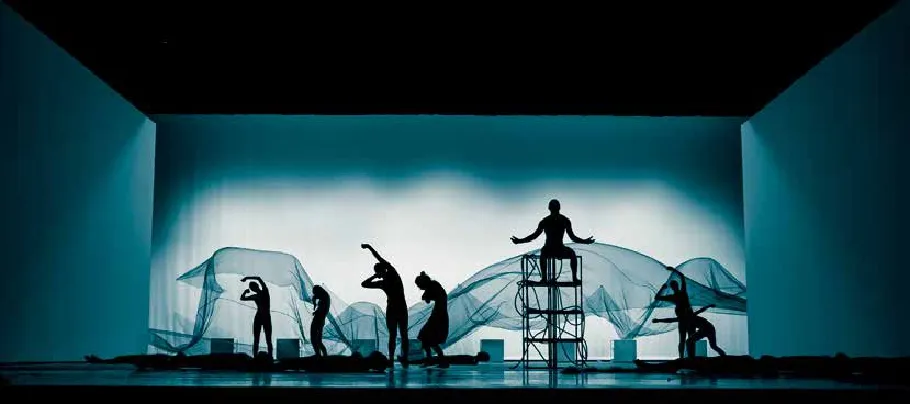
萬瑪尖措“夢想一日回歸山野,砍柴、種田、喂馬、放牧,無限歡喜”。萬瑪尖措是安多藏族人,1979 年出生在青海省海南藏族自治州,青藏高原黃河邊的卡里崗村莊。父親是當地藝術樂團團長,童年生長在藝術氣息濃厚的文藝大院以及單純溫馨的家庭。由于國家對少數民族地區教育的相關政策和各種機緣巧合,在 1992 年 9 月,13 歲的他身負父親的厚望,并且帶著對外界的好奇和興奮,從家鄉來到北京求學,十年光陰從民大附中到民大舞蹈學院首屆本科生 , 接受了專業的學院派民族舞蹈教育。
萬瑪本科畢業后的工作經歷了多重選擇,最終以自由舞蹈創作者的身份運營著“體制外”的民營舞蹈院團,接受著來自市場的各種考驗。現如今盡管有一系列頭銜諸如萬瑪舞蹈劇團創始人、藝術總監,美國芝加哥西林藝術中心藝術總監中國文化促進委員會委員、沈陽音樂學院客座教授等等,仍以“一介舞夫”自居,“非家不著名,平靜得自在,相信而堅持,且舞且行,無限歡喜”。在這一系列頭銜和“明星”光環的背后,除了腳踏實地的步步艱辛和對舞蹈藝術的執著熱愛,也暗含著他對自我生存狀態的思考以及對本民族文化的認同和歸屬。
香巴拉最初的文學劇本來自于萬瑪13歲那年的日記。而日記的內容有感于那一年親身經歷的天葬場景。兒時的他所看到的那種恐怖的、驚悚的、充滿血腥味的畫面給他帶來了莫大的震撼,母親告訴他,“不要害怕,他們去了香巴拉”。第一次聽到“香巴拉”,懵懵懂懂地產生好奇,引發他追尋“我是誰、從哪里來”等生命終極答案。于是在多年沉淀下,總結童年的回憶、族群身份的認同與反思,在這部舞劇中重點探索了藏傳佛教生死輪回的思考。
作為藏族,萬瑪了解西藏的文學、宗教、風俗、習俗等,對其具有深厚情感,立志繼承民族文化。當然,他也很歡迎其他民族關注、愛好、學習及融入藏族文化。而藏族文化中,最重要的就是信仰部分;沒有藏傳佛教,就沒有西藏文化。
作為佛教徒,萬瑪尖措認為,人們看到出生就歡喜,看到死亡就悲哀、恐懼,但佛教看生既非起點,死也不是終點,未成佛前一直都要輪回。所以我們應該放下對此生的執著,節制欲望,保持心境平和。他個人認為,物質和精神兩種追求應該平衡,只偏重其中一者,都會產生問題。香巴拉正是物質與精神的支點。那里既有優美的環境,也有心靈的修持,兩個層面可以和諧共生。
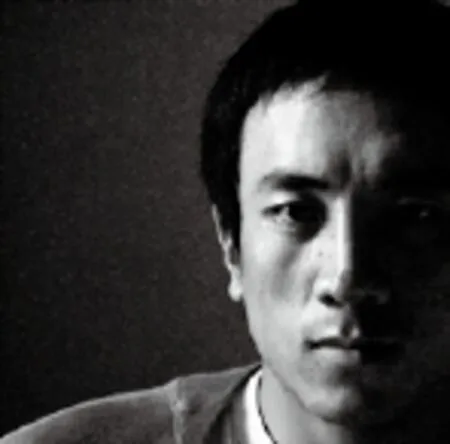
WANMA JIANCUO THE REDISCOVERY OF THE ORIGINAL BEING
Art comes from life, and goes beyond it. Dancer Wanma Jiancuo’s performance in the musical Shambhala tells much more than human’s sheer yearning for paradise - it also conveys the artist’s understanding of the cycle of birth and death. Beneath his performance, lies Wanma Jiancuo’s childhood memory, his recognition of his identify and his spiritual belief.
Text by Yang Yin Translation by Madeline Weng, Shi Yu Photos Provided by Wanma Jiancuo

Shambhala allows Wanma Jiancuo to go to a place in art unattainable for most people. Whilst watching Shambhala, viewers are able to fully enjoy the tranquility and peaceful feeling brought by the show.
“Shambhala” is a transliteration from Tibetan. It is also translated as “Shangri-La”, meaning“paradise”. Legend has it that there was once a kingdom seated among north India, Kashmir, and the Himalayas. When Sakyamuni from the ancient India became a Buddha, he was invited to preach in Shambhala. After his sermon, the entire kingdom began to practice this mysterious magic, and thus became an unseen pure land, in which everyone wears a rainbow and lives in an abundance of happiness. This legendary kingdom later became the most sought after paradise for believers who wished for a next-life in Shambhala.
It is also Wanma Jiancuo's dream, to be able to return to nature, and indulge himself in the simple pleasures such as farming and feeding horses.
Born in 1979, Wanma Jiancuo is an Anduo Tibetan from a village in Qinghai, which is located by the Yellow River that flows through the Tibetan Plateau. With his father as the leader of the local Orchestra band, Wanma grew up in an artistic atmosphere. In 1992, the 13-year-old boy left his hometown to pursue an education in Beijing. Ten years flew by, and Wanma graduated as one of the first students from Central University of Nationalities. All the hard training he had during those ten years later proved to be beneficial to his dancing career.
Wanma was faced with many choices when he first graduated. However, he chose to become an individual dancer in a private dance company instead of accepting the arranged position in the system. He felt it necessary to go through the tests of the market.
Although he has been given numerous titles such as “Art Director and Founder of Beijing City Shepherd Studio”, “Professor of Shenyang Conservatory of Music”, Wanma still prefers to simply call himself a dancer. He said∶ “I believe in modesty and a peace of mind, instead of titles and honour. Dancing itself gives me infinite joy.”

The original script of Shambhala came from Wanma's dairy. When he was 13 years old, he wrote about his first experience in witnessing a celestial burial.The striking image and the bloody smell shocked him greatly. His mother, however, whispered in his ear∶ “Don't be scared, my child. They have gone to Shambhala.” Hearing this word for the first time, Wanma could not fully understand what it meant; yet he was curious and interested. Young as he was, he started to ask himself questions like “who am I?” and“where do I come from?”
Through years of pursuing the philosophy of life, he came up with the dance drama Shambhala, which combines both his reflection of his childhood and his understanding of his identity.
As a Tibetan, Wanma understands Tibetan culture. He has deep feelings for Tibet, and has set his mind to inherit their valuable culture. He believes that the most essential part for Tibetan culture is the religion. “There would not be Tibetan culture if there hadn't been Tibetan Buddhism.”
As a devoted follower, Wanma Jiancuo believes that birth is not the beginning and neither is death the end. Instead, everything will forever exist in a circle, until one becomes the Buddha. Therefore, he says, we should put down the persistence on this life, try to control our desires, and maintain a peace of mind.
“There must be a balance between the spiritual and material. An inclination towards either side would bring out problem,” he said, “and Shambhala is this pivotal point. It is where these two layers of our life can coexist harmoniously.”
Wanma Jiancuo, Tibetan, choreographed Hot Drum, Passionate Dance, the Best Choreography Award winner by the Canadian Arts Festival Commission Running Away wins the Gold Medal for Creation in the National Dance Competition
Silent Marnyi Stone wins the Gold Award at Seoul International Dance Competition
萬瑪尖措,藏族,創作舞臺劇《熱鼓熱舞》并獲得加拿大藝術節委員會最佳編舞獎舞蹈《出走》榮獲全國舞蹈大賽創作金獎。
舞蹈《靜靜的瑪尼石》獲得韓國國際舞蹈大賽金獎
N=NIHAO
W = WANMA JIANCUO
N: As a Tibetan dancer, how did you develop under different cultural backgrounds?
W: Inspired by Pina Bausch, German modern dance master, I started to do dance theatre. Based on her concept of “Tanzetheater”, meaning “dance theatre”, I combined these utterly powerful aesthetics of body with my own ideology. What I expect is not for the traditional dance drama to unfolded chapter by chapter, but a highly integrated theatre performance. My principle is cultural identity of ethnicity, and my source is the Tibetan culture, including music, dance and religion. So wherever I present my performance, the cultural recognition given by Tibetan audiences will always be the final factor weighing whether it is a success or not.
N: As an artist, how do you evaluate the relation between artistic creation and the popular demand?
W: Let's take Shambhala as example. Tibet is my hometown. What's the difference between the hometown in my understanding and Tibet in most people's understanding?
Most people fancy the mystery of an exotic land, whilst I live my life there, for real. It's in my eyes and it's in my mind. I want to express a theme, and this quiet and exotic way cannot express the legends that I've seen in Tibet. What I need is a roar, either at the top of my voice or as pensive as can be, to set up a bridge between “life” and“death” and this will be closer to the real life. So in the performance of Shambhala we can see a heavily-loaded body walking slowly, we can see breath gets softened in the sound of the Tibetan bell, and we can also see the power that can reach for the top of the sky and the bottom beneath the ground.
N: Let's talk about the theatrical interpretation of Shambhala.
W: Newly interpreted with modern dance and live performance art, Shambhala absorbes elements from traditional Tibetan dances. The source of the interpretation is from the daily life of the Tibetan people. For example, how Tibetan pilgrims join their hands together devoutly and creep on the ground is presented in this way∶ touch the forehead, jaw, and chest softly with the forefinger of the right hand; and then take a deep breath; and finally kneel. They are all simple movements, quiet and slow though, the emotion will be fully expressed at every moment the actor touches the ground.
The figure of Buddha appears several times during the drama. The dancers' gestures sometimes look like the figure of Buddha dancing, creating a strong sense of motion. And also I flexibly use the props, giving them more symbolisations. No direct narrations, through moments of dead space, the form of the prop leaves the audience more space for thinking.
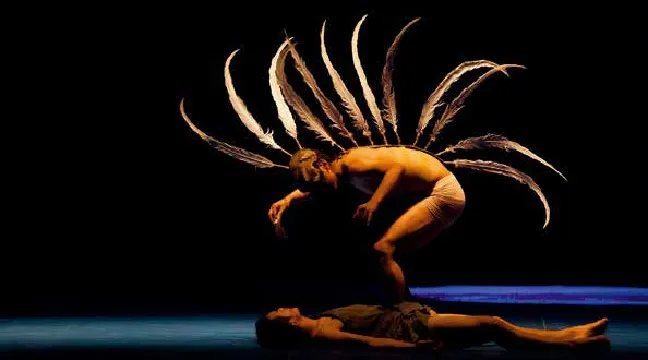
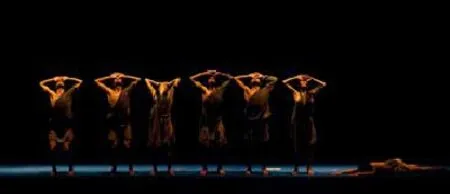
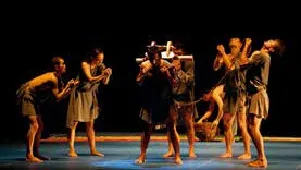
N:作為藏族舞者,你在不同的文化背景下是如何成長的?
W:我做舞蹈劇場是因為受到了德國現代舞大師皮娜·鮑什的影響。借用她開創的“舞蹈劇場”的概念,將這種“摧枯拉朽”的嶄新肢體美學融入到自己創作的理念中。我所期待的不是傳統的情節性分章分節的舞劇形式,而是一種手段高度綜合的劇場演出形式。族群文化認同是我的創作原則。藏族文化,包括音樂、舞蹈和宗教信仰是我藝術創作的根基。所以無論我將作品帶到世界何地,藏族觀眾的文化認同都會是我衡量這部作品是否成功的最終考量。
N:作為藝術家,你如何看待藝術創作與大眾心理需求間的關系?
W:舉《香巴拉》為例。西藏是我的故鄉,我所理解的故鄉和大眾所理解的西藏究竟存在何種差異?大眾需要異域神秘,而我的故鄉是生活,可能只在眼神中、在心中。對于我表達的題材,這種安靜的表達方式不是我們所看到的西藏“傳奇故事”,需要聲嘶力竭或是故作深沉地搖旗吶喊,而在“生”與“死”之間架起了橋梁,更接近一種十分真實的生活狀態。所以我們看到了背著沉重行囊俯身緩慢行走的身體,看到了在法鈴聲中軟化的呼吸,看到了手觸天空腳陷大地的張力。
N:請你談一談《香巴拉》的舞臺語言。
W:《香巴拉》融合了西藏弦子舞、金剛舞等傳統藏族舞蹈的元素,以現代舞和現場行為藝術的方式進行了全新演繹。舞蹈的代表性語言素材正是源于日常生活絮語,朝圣者雙手合十俯地前行——用舞臺語言呈現則是“右手食指輕觸額頭、下巴、心口,再呼吸含胸沉膝”,動作極簡,平靜而緩慢,情感卻凝結在與大地親密接觸的每一個瞬間。
舞劇中多次出現藏傳佛教中佛像的造型:赤足擰腰,蓮花手五位攤開,身體前傾,右腿曲起、左腿獨立,頭尖略微傾斜,目視左前方。似是呈舞蹈姿勢的智行佛母立像,營造出強烈的動感。我對于道具的運用是很靈活的,有很多象征性意味的言說。它并不固定直白地敘說,而是賦予道具以形式感,通過留白將更多的思考空間留給觀眾。

